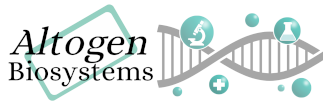Shop Products
In Vitro Cytotoxicity Assays and IC50 for 120 Tumor Cell Lines
In Vitro Cytotoxicity Assays and IC-50 for 120 Tumor Cell Lines
Cytotoxicity Assays
Altogen Labs offers a number of cell-based tissue culture assays, such as flow cytomerty and microplate-based cell proliferation and cytotoxicity assays (including cell cycle, cell viability, membrane protein expression, TUNEL, caspase 3/7 apoptosis, etc). Standard MTT cytotoxicity assays are based on the cleavage of the yellow terazolium salt (XTT) by metabolically active human cells (usually HeLa or A549 cells) to form an orange formazan dye. This conversion only occurs in viable cells, so cytotoxicity leads to a loss of activity. The formazan dye formed is soluble in aqueous solutions and is directly quantified using a scanning multi-well plate reader (spectrophotometer). Multiple replicates ensure that this method provides a high degree of accuracy and statistical data confidence. The assay is suitable for the performance of dose-response studies and is offered in a 96-well microplate format.
Cytotoxicity assays can be necessary for a variety of reasons; initial drug screenings require a thorough understanding of how a given drug impacts cells, and other kinds of testing may require knowledge of cellular responses to introduced reagents. Cytotoxicity assays provide the information necessary for determining future screenings of drugs in vivo, and can also give valuable insight into the cytotoxic effects of other compounds. Such information can inform pre-clinical trials, and will also give an early indication of poisonous properties of compounds.
IC-50 Assays
IC-50 testing service is offered in over 120 in-house cell lines and primary cell types or any custom (client provided) cell line. The goal of this test is to measure the biological activity of a compound of interest (IC-50) against different types of tumor cell lines. In standard setup, cells in logarithmic growth are seeded in 96-well tissue culture plates (5,000-7,500 cells/well). Appropriate negative and positive controls are used in the assay (control conditions usually include the nontreated cells, cells with medium and vehicle as a negative control and one of the standard chemotherapy drugs as a positive control). Plates are assayed at 48-72 hr after initiation of compound exposure, then a 3-[4,5-dimethylthiazol-2-yl]-2,5-diphenyltetrazolium bromide (MTT) solution is added to each well for a 1- to 3-h incubation (at 37°C and 5% CO2). Analysis is performed at least in triplicate (biological replicate) and using a plate reader to generate IC-50 assay data.
The IC-50 assay is incredibly important in cancer research, as it provides quantitative information regarding specific dosages of drugs and their effects on cell lines. For cancer drug screenings, the IC-50 assay is an absolute necessity, as it can be used to determine the concentration of a drug to be used for in vitro screenings, which will precede clinical trials. The assay requires large amounts of individual wells to be used for different concentrations of drugs, and as such it requires considerable precision and effort to complete successfully. As such, reproducibility can be greatly increased if the assay is conducted by a company with pre-determined standard procedures for its execution.
Click here to request IC-50 service instant quote
What is In Vitro Cytotoxicity and IC50 Assays
In vitro cytotoxicity assays are laboratory techniques used to measure the toxicity of a compound or substance on cells in culture. These assays are commonly used in drug discovery and development to identify compounds that have toxic effects on cancer cells or other target cells, and to determine the dose at which a compound causes cell death.
The assays typically involve exposing cultured cells to varying concentrations of a compound, and measuring the extent of cell death or inhibition of cell growth. The IC50 (half maximal inhibitory concentration) is the concentration of the compound that causes a 50% reduction in cell viability or growth.
There are several types of in vitro cytotoxicity assays, including:
- MTT (3-(4,5-dimethylthiazol-2-yl)-2,5-diphenyltetrazolium bromide) assay: This assay measures the metabolic activity of cells, which is an indicator of cell viability. MTT is a colorimetric assay that measures the conversion of MTT to formazan by mitochondrial enzymes in living cells.
- LDH (lactate dehydrogenase) assay: This assay measures the release of LDH, an enzyme that is released from damaged or dying cells, into the culture medium. LDH assay is a simple and widely used method to assess cytotoxicity.
- ATP (adenosine triphosphate) assay: This assay measures the amount of ATP, an indicator of cell viability and metabolic activity, in cells using a luminescent or fluorescent assay.
In vitro cytotoxicity assays are valuable tools for screening large numbers of compounds and identifying potential lead compounds for further development. However, it is important to note that in vitro assays may not always accurately reflect the effects of compounds in vivo, and further testing in animal models and clinical trials is necessary to determine the safety and efficacy of potential drugs.
Click here to request IC-50 service instant quote
Please contact us at techserv@altogen.com for more information. Experimental details will help us to provide an accurate project quote and time line estimate.




